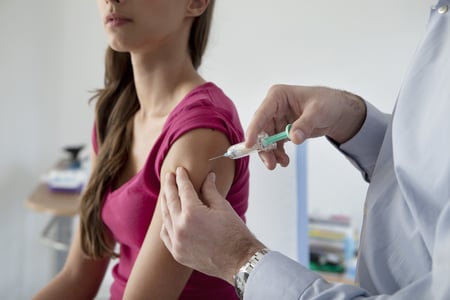6 Things to Know About a Cervical Cancer Diagnosis
5 min read

Thousands of American women each year learn they have cervical cancer after an abnormal Pap smear in their OB-GYN’s office, prompting additional testing. In 2023 alone, the American Cancer Society estimates that nearly 14,000 new cases of cervical cancer will be diagnosed.
After a cervical cancer diagnosis, what happens next? Here are six things to keep in mind.
1. Screening Makes a Big Difference When It Comes to Cervical Cancer
If you’ve been keeping up with your cervical cancer screenings, it’s more likely the cancer will be detected in the earliest stages, often before it spreads to other parts of your body.
The Pap smear/HPV test combo is probably the best screening test that we have for any type of cancer. Every case of cervical cancer could be picked up by a screening before it even becomes cancer. If we can detect cervical cancer in the early stages, outcomes are much better. Women never have to worry about being treated for a cancer that theoretically could have been cured.
2. The Most Effective Cervical Cancer Screenings Vary by Age
Cervical cancer screening guidelines shift over time. In the past, screenings usually began once a girl or woman became sexually active. That’s no longer the case. Today's guidelines call for screening to start at age 21 and will change as a woman gets older.
 Cervical cancer is caused by the human papillomavirus (HPV). A lot of young girls will pick up the virus when they become sexually active, but it will usually clear on its own quickly without any treatment. That’s why we now wait until the age of 21 to begin screening in most cases.
Cervical cancer is caused by the human papillomavirus (HPV). A lot of young girls will pick up the virus when they become sexually active, but it will usually clear on its own quickly without any treatment. That’s why we now wait until the age of 21 to begin screening in most cases.
Young women should have a Pap smear every three years until age 30. At that point, the guidelines recommend a Pap smear and an HPV test every 3 to 5 years.
Age 30 is around the time we start to see persistent strains of HPV that stick around and can lead to cervical cancer. That’s why we screen periodically using both Pap smears and HPV testing. HPV testing is very important for catching the potential for cancer that we wouldn’t otherwise pick up using a Pap smear.
3. Both Types of Screening Tests Are Important
In the past, doctors used Pap smears almost exclusively for cervical cancer screening. During a Pap smear, a doctor takes a sample of cervical cells to detect precancerous cells and other abnormalities.
In the last decade, HPV tests have also become commonplace.
HPV testing detects whether cervical cells contain specific strains of HPV that increase the risk of developing cervical cancer.
Medical providers can use these two screening tools to diagnose cervical cancer and create a treatment plan. Your OB-GYN or primary care provider can recommend the best screening strategy for your specific needs, including cervical cancer risk factors.
4. Cervical Cancer Is Treatable in Early Stages
Innovations in cancer diagnosis and treatment have made cervical cancer much more survivable in the last few decades. When cervical cancer is found in an early stage, the five-year relative survival rate for the condition is 92%, according to the National Cancer Institute.
For nearly all cancers, staging has the most important impact on what’s going to happen to patients. Cervical cancers detected in early stages have about an 85% to 95% cure rate. If it increases to stage 2 or stage 3, it’s about 65%. In stage 4, the survival rate is much lower because the cancer has spread beyond the cervix. If we can catch this as a precancer, we don’t go through all this.
5. New Cervical Cancer Treatment Options Can Preserve Fertility
Another area that has rapidly evolved and improved over the past few decades is cervical cancer treatment. In the past, treatment was typically always invasive, which meant young women often didn’t have the option to become pregnant following treatment.
Today, cervical cancer treatment usually takes one of two paths: surgery or a combination of radiation and chemotherapy. Surgeons can use less invasive techniques for women who wish to preserve their fertility after cervical cancer.
When it comes to treatment, a lot has evolved in the last 10 years. We’ve gone from more radical procedures to less radical procedures for specific groups of people. Early cervical cancer that meets certain criteria allows us to use less-invasive surgical procedures so that we can save the uterus, allowing some women to go on and get pregnant and carry a pregnancy.
When choosing a type of cervical cancer treatment, your doctor will consider overall health, age, and stage of life.
The type of treatment we recommend depends on the stage of cancer, how big the tumor is, and whether it’s spread beyond the cervix. In later stages, the standard of care is chemotherapy and radiation used together. We use IMRT, a type of radiation that does a good job of targeting the tumor with less damage to unaffected tissues. Treatment includes four to six weeks of radiation and a single chemotherapy drug for the same duration.
6. It Is Possible to Prevent Cervical Cancer in Many Cases
If you are sexually active, you are at risk of contracting the HPV virus, which causes cervical cancer and other health issues. There are ways, however, to lower your risk.
 Getting an HPV vaccine is an essential first step. The Centers for Disease Control and Prevention recommends HPV vaccines for both boys and girls at age 11 or 12 – but the vaccine can also be effective through age 26 and even older, in some cases.
Getting an HPV vaccine is an essential first step. The Centers for Disease Control and Prevention recommends HPV vaccines for both boys and girls at age 11 or 12 – but the vaccine can also be effective through age 26 and even older, in some cases.
Talk with your medical provider about whether vaccination could benefit your specific needs.
Beyond the HPV vaccine, you can take another step to prevent cervical cancer. Regular cervical cancer screenings can help detect precancerous cells before they develop into cancer. At this point, doctors can remove these cells from the cervix before they become cancerous and spread.
Of all the gynecological cancers, the best screening tools we have are for cervical cancer. Have Pap smears and HPV tests done regularly so that these cells can be picked up in a precancerous stage and taken care of much more easily.
If you’ve been diagnosed with cervical cancer, RMCC can help you navigate the cancer journey from diagnosis through recovery. Request an appointment today.